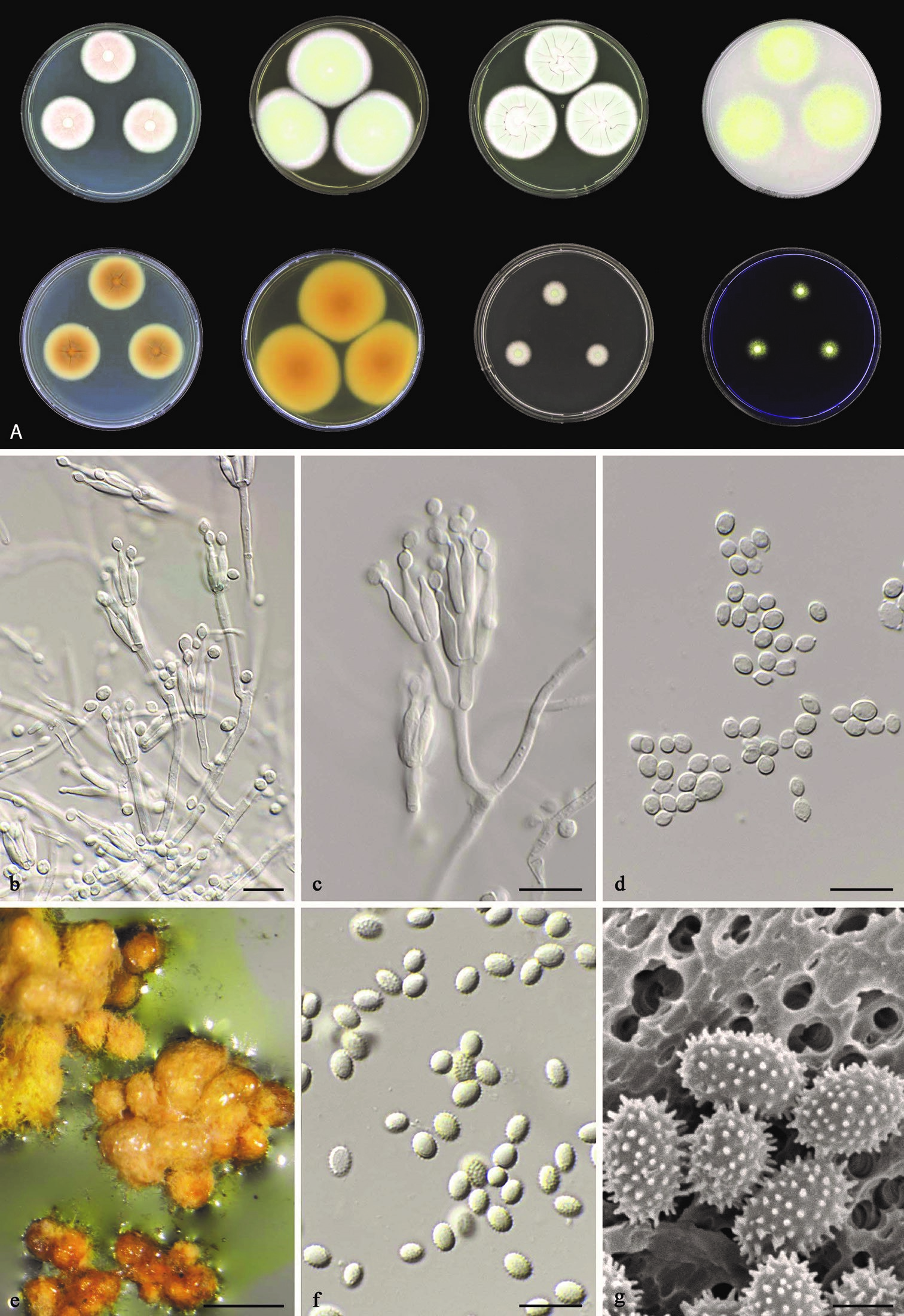 269
269
Talaromyces brevis B.D. Sun, A.J. Chen, Houbraken & Samson 2020
MycoBank No: 833132
Holotype: China, Beijing, soil, 2010, isolated by B.D. Sun, Holotype CBS H-22831, culture ex-holotype CBS 141833= DTO 349-E7.
Morphological description
Colony diam, 7 d (mm). CYA 30–31; CYA 30 °C 28–30; CYA 37 °C 25–26; MEA 50–51; MEA 30 °C 57–60; OA 39–43; YES 42–43; CREA 13–14; CYAS No growth; DG18 13–15.
Colony characters. CYA 25 °C, 7 d: Colonies moderately deep, sulcate; margins entire; mycelium white and flesh (37); texture floccose; sporulation sparse; conidia en masse white; soluble pigments absent; exudates absent; reverse ochreous (44). MEA 25 °C, 7 d: Colonies moderately deep, plane; margins entire; mycelium white and primrose (66); texture floccose; sporulation sparse; conidia en masse white to greyish yellow-green (68); soluble pigments absent; exudates absent; reverse ochreous (44). YES 25 °C, 7 d: Colonies moderately deep, sulcate; margins entire; mycelium white; texture floccose; sporulation absent; soluble pigments absent; exudates absent; reverse ochreous (44). DG18 25 °C, 7 d: Colonies moderately deep, slightly raised at center, plane; margins entire; mycelium white; texture floccose; sporulation moderately dense; conidia en masse yellow-green (71); soluble pigments absent; exudates absent; reverse greyish yellow-green (68). OA 25 °C, 7 d: Colonies moderately deep, plane; margins entire; mycelium primrose (66); texture floccose; sporulation absent; soluble pigments absent; exudates absent; reverse primrose (66). Ascomata present. CREA 25 °C, 7 d: Moderate growth, acid production present.
Micromorphology. Conidiophores monoverticillate and biverticillate; stipes smooth, 15–50 × 3–4 μm; metulae 3–5, divergent, 10–15 × 2.5–3 μm; phialides 4–6, flask-shaped, 9–13 × 2–4 μm; conidia smooth, subglobose to fusiform, 3–4(–5) × 2.5– 3.5(–4.5) μm. Ascomata maturing after 2–3 wk of incubation on OA, yellow to orange, globose to subglobose, 400–550 μm; ascospores ellipsoidal, spiny, 3.5–4.5 × 3–4 μm.
Habitat: soil.
Distribution: China.
GenBankAccession:ITS:MN864269;BenA :MN863338;CaM :MN863315;RPB2 :MN863328.
Notes: Talaromyces brevis is morphologically and phylogenetically close to T. liani, but the latter produces larger ascospores measuring 4–6 × 2.5–4 μm and does not produce acid on CREA (except T. liani CBS 118885 produces very weak acid) (Yilmaz et al. 2014).
Reference: Sun B-D, Chen AJ, Houbraken J (2020) New section and species in Talaromyces. MycoKeys 68: 75–113. https://doi.org/10.3897/mycokeys.68.52092
Talaromyces brevis CBS 141833T a colonies from left to right (top row) CYA, MEA, YES and OA; (bottom row) CYA reverse, MEA reverse, DG 18 and CREA b–d conidiophores and conidia e ascomata on OA after two weeks f–g ascospores. Scale bars: 10 μm (b–d, f), 1000 μm (e), 2 μm (g).

